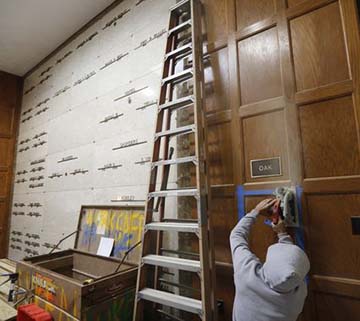As cremations rise, cemeteries rethink land use
OH – At 71 years young, Lois Griswold of Wyoming is starting to get her “ducks in a row.” Griswold isn’t facing imminent challenges to her health and vitality, but she and her husband, Gary, 67, visited Arlington Memorial Gardens in Springfield Township to identify a ground burial alternative.
“It’s about making things easier for our children so they don’t have a lot of problems when we die,” said Griswold, who describes herself as a born-again Christian. “We don’t have any trouble talking about dying because we know where we’re going.”
Local cemetery operators and national industry analysts say the Griswolds are part of a larger shift in consumer preferences away from ground burials. As a result, cemetery operators are trying — and in some cases struggling — to figure out how best to serve clients on the land they occupy.
Adoption of ground burial alternatives is happening slower in Ohio and Kentucky than in other parts of the country. But the pace of adoption is helping leaders from some area cemeteries rethink what could be added to typically pastoral landscapes.
Changing tastes drive action
Customer concerns about the environment, burial costs and shifts in religious doctrines toward cremation are all influencing demand for alternatives, said Bob Fells, executive director and general counsel for the International Cemetery, Cremation and Funeral Association.
Rates of cremation are steadily rising in the United States and now are completed following about 42% of deaths, Fells said.
Arlington’s first mausoleum was built in 1986, and the cemetery now has seven. The $1.5 million remake of the Lakeside Chapel Mausoleum, which added 420 crypts, 176 columbarium niches and updated building features, is the latest piece of responding to changes in demand. In late 2015, Arlington plans to open a funeral home on more than eight acres of land that’s now undeveloped.
These developments are part of the 10-year expansion plan for the 165-acre Arlington that began in 2010. The plan doesn’t involve the 80-year-old cemetery’s land footprint increasing, but using 12 additional acres of land it already owns. Today, about 30 acres of cemetery land between Compton Road and the Ronald Reagan Cross County Highway remains undeveloped.
Fewer burials could mean a new lease on life for cemeteries with little space left, Fells said. But that remains a key — and sometimes the sole source — of revenue for these operations. Which means development decisions are calculated risks based on the operating model, future burial demand and land-management costs.
Fells said among the more creative uses for cemeteries is leasing land for cellular phone towers, providing operators with an extra source of income. However, alternative uses for cemetery land typically require zoning changes.
“There are options out there that can be pursued as long as it seems to be for the benefit of the cemetery, the families and the communities at large,” Fells said.
Although Griswold is still evaluating options for her final resting place, ground burial isn’t part of them. She even turned down a free cemetery plot in Schenectady, N.Y., where members of her extended family reside. She says Arlington’s mausoleums are attractive because, although the location of her body doesn’t matter to her, it will be important for her family and friends.
“People who didn’t know me would walk all over my final earthly resting place, and mowing machines and burial trucks will be driving over it,” Griswold said. “In a mausoleum, my body will be tucked away in a place where snow, rain, feet and machines will not be going.”
No big changes at many cemeteries
Jerry Wantz, vice president of operations at Spring Grove Cemetery and Arboretum, said he doesn’t get calls from real estate developers, and that isn’t likely to change soon. Spring Grove in Cincinnati occupies about 750 acres, about 300 of them in their natural wooded state, he said. The Cincinnati cemetery is the nation’s second largest single cemetery site.
Oak Hill Cemetery in Glendale, which Spring Grove’s management operates, has about 45 of its 100 acres developed.
“We would never sacrifice any of our land,” Wantz said. “We’re very fortunate we have a lot of land here.”
Spring Grove and Oak Hill are adjusting offerings to support customers who want ground burial alternatives, Wantz said. Next year, Spring Grove will add a more than 1,100-niche columbarium that will surround the cemetery’s “Fountain of Faith.”
Overall, interments are up 10% this year from 2013, and cremation represents about 35% of them, he said.
Among Highland’s popular public features is the five miles of hiking trails developed in the 1990s, Honebrink said. Five acres of land were also dedicated for a pet cemetery in 1995.
About half of the 251 acres at Highland, one of Kentucky’s largest cemeteries, is developed. More than half of the 110-acre Independence Cemetery land is developed. The Independence cemetery doubled its size in 1996 after buying 64 acres of adjacent farmland.
Honebrink said the board overseeing Highland and Independence cemeteries has had discussions about developing a funeral home, crematorium, reception hall and monument markers. For now, the board “is keeping things at the status quo and do what we’ve done for 140 years, and that’s take care of burial process,” he said. “(But) the future is inevitable.”
Photo: An expansion is underway at Arlington Memorial Gardens’ Lakeside Chapel Mausoleum. The Enquirer/Carrie Cochran
Originally published by the Cincinnati Enquirer, author Bowdeya Tweh.


Leave a Comment
You must be logged in to post a comment.